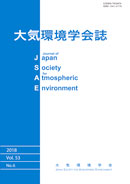
- Issue 6 Pages 207-
- Issue 5 Pages 153-
- Issue 4 Pages 111-
- Issue 3 Pages 79-
- Issue 2 Pages 25-
- Issue 1 Pages 1-
- |<
- <
- 1
- >
- >|
-
Toshimasa Ohara2018Volume 53Issue 6 Pages pref06_1
Published: November 10, 2018
Released on J-STAGE: January 11, 2019
JOURNAL FREE ACCESSDownload PDF (190K)
-
Ikue Saito, Tokuko Tsunoda, Aya Onuki, Tomoko Okubo, Tsuyoshi Igarashi ...2018Volume 53Issue 6 Pages 207-218
Published: November 10, 2018
Released on J-STAGE: January 11, 2019
JOURNAL FREE ACCESSIn this study, a separation and quantification method for ammonium sulfate in ambient PM2.5 was developed. Aqueous solutions of four major ammonium salts in PM2.5, i.e., ammonium sulfate, ammonium hydrogen sulfate, ammonium nitrate and ammonium chloride, were added to a quartz fiber filter and dried. Next, the filter was subjected to heat treatment to separate the ammonium sulfate from the other ammonium salts. By heating the filter to 110℃ for 30 min, ammonium nitrate and ammonium chloride volatilized, and only ammonium sulfate and ammonium hydrogen sulfate remained on the filter. Furthermore, by heating the filter to 150℃ for 30 min, the ammonium sulfate splits into ammonium hydrogen sulfate and ammonia, so half of the NH4 in the ammonium sulfate volatilized. The other sulfate salts that were estimated to be present in PM2.5, i.e., sodium sulfate, potassium sulfate and calcium sulfate, did not decrease by the heat treatments at 110℃ and 150℃. Hence, after the heat treatments, the ammonium ion, which decreased by heating at 150℃ compared to heating at 110℃, was confirmed to originate from the ammonium sulfate. Thus the concentration of ammonium sulfate in the PM2.5 was estimated from the decreased ammonium ion concentration and the ratio of the formula weight. Using this developed method, the concentration of ammonium sulfate in ambient PM2.5 was estimated to be 1.8 μg/m3 in January and 2.5 μg/m3 in February, 2018.
View full abstractDownload PDF (851K) -
Syuichi Itahashi, Hiroshi Hayami2018Volume 53Issue 6 Pages 219-236
Published: November 10, 2018
Released on J-STAGE: January 11, 2019
JOURNAL FREE ACCESSBefore the environmental standard value for PM2.5 was introduced in 2009, the observed PM2.5 in Japan showed the gradual decreasing trend. In this study, in order to clarify the reason of this gradual decreasing trend of PM2.5, the long-term source apportionments of PM2.5 in Japan during 2000–2008 were evaluated based on the air quality model by applying the tagged tracer method. The source groups were divided into total of 11; six domestic anthropogenic sources, three foreign anthropogenic sources from China, Korea, and other regions, and ship and natural sources. The performances of the air quality model were validated by a statistical analysis, and confirmed that the modeling system satisfied the model performance criteria. The domestic anthropogenic sources were higher than the abroad anthropogenic source on 2000–2001; and subsequently the relationships were reversed. This increasing abroad anthropogenic sources was mainly caused by the impact from China. The source apportionment of abroad anthropogenic sources had increased; however, due to the decline of natural sources and significant decline of domestic automobile sources (p<0.001), it was clarified that PM2.5 in Japan showed the gradual decreasing trend. Other sources of power plant, industry, domestic, and others in Japan showed unclear trends.
View full abstractDownload PDF (7949K)
-
[in Japanese]2018Volume 53Issue 6 Pages 237-238
Published: November 10, 2018
Released on J-STAGE: January 11, 2019
JOURNAL FREE ACCESSDownload PDF (277K)
-
Takaya Higuchi, Hiroyuki Ueno, Hidemoto Sukekawa2018Volume 53Issue 6 Pages A89-A101
Published: November 10, 2018
Released on J-STAGE: January 11, 2019
JOURNAL RESTRICTED ACCESSDownload PDF (1383K) -
Kengo Sudo2018Volume 53Issue 6 Pages A102-A113
Published: November 10, 2018
Released on J-STAGE: January 11, 2019
JOURNAL RESTRICTED ACCESSDownload PDF (3377K)
-
[in Japanese]2018Volume 53Issue 6 Pages A114-A115
Published: November 10, 2018
Released on J-STAGE: January 11, 2019
JOURNAL FREE ACCESSDownload PDF (315K)
- |<
- <
- 1
- >
- >|